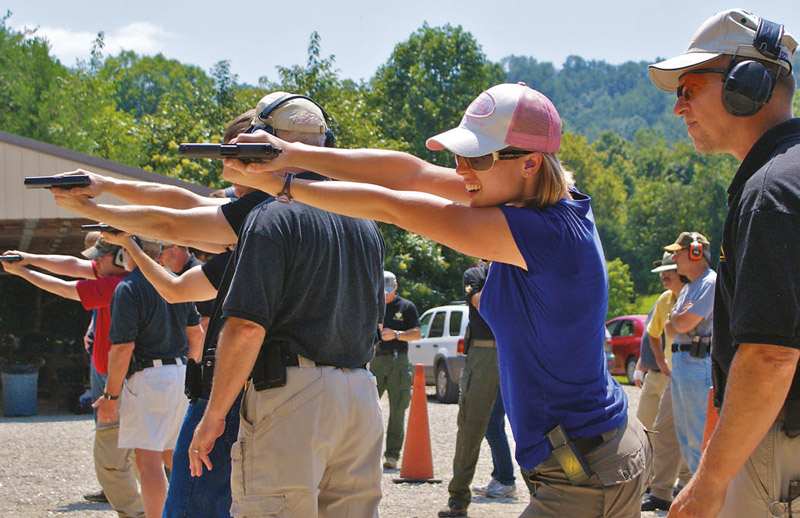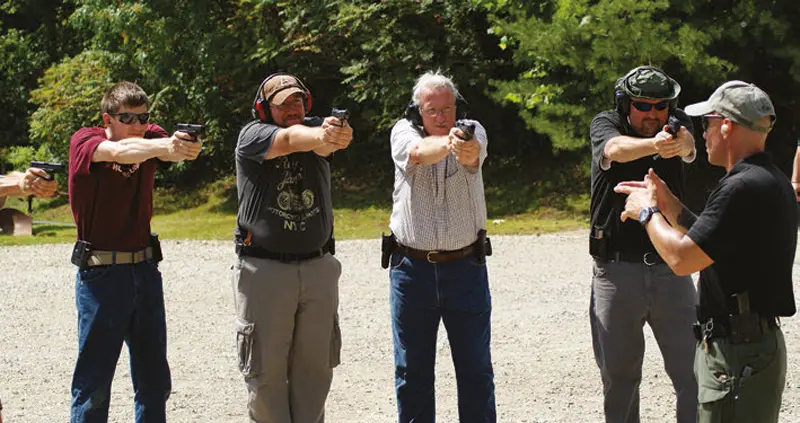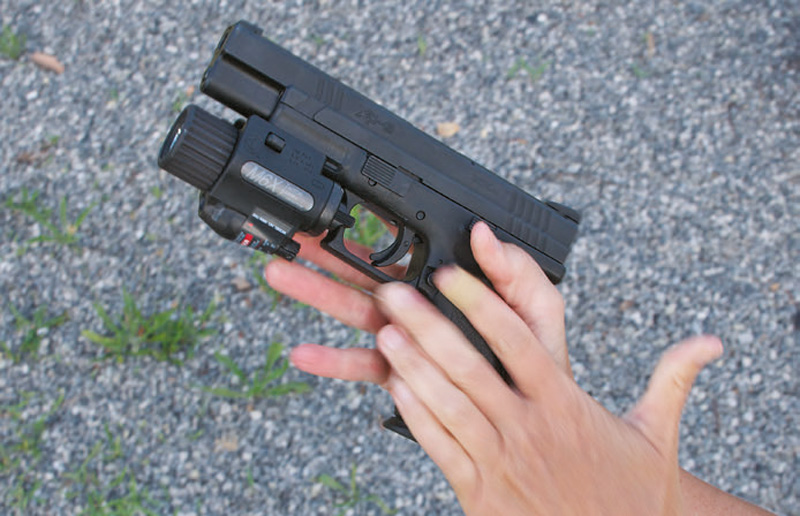
While attending Tactical Defense Institute’s (TDI) rifle training courses over the past three years, it became evident that my pistol-handling skills could use some polishing. When the opportunity arose to attend Level I-III Handgun, I seized it.
From the outset, I knew this was going to be a very interesting course, as five students out of a class of 16 were women. Sadly, that number is actually high for most of the courses I’ve attended. There’s a serious lack of female representation in the shooting world, and that needs to be remedied.
I was also pleased to see several fathers attending this course with their young adult kids. Having such a diverse group of people made for some great conversation during the first day of training, which began in the classroom.

Table of Contents
TDI SETTING AND STAFF
Based in the rolling hills of Bethany Ridge, Ohio, TDI offers a diverse curriculum. They have a dynamic facility with various courses of fire, shoot houses, a climate-controlled classroom, and a welcoming staff.
Our instructors for the three-day course were John Benner, David Bowie, John Motil, Joe Wicker, Bill Posey, Dick Wheeler, Gary Huff, Nancy Strope, and Clay Smith. All are seasoned instructors who were never more than an arm’s length away without being obtrusive. I’ve found that TDI instructors are adept at conveying instruction with little preamble, move with a purpose, and skillfully run each student through the myriad of skill-building drills, multiple times if needed or requested.

TDI staff opened the course with welcomes and introductions. Next we moved into covering deadly force issues, what to do if you’re involved in a shooting, post-shooting trauma, socialization, mindset, and personal assessment. Other issues that pertain to constitutional law and legal justifications for using force were also covered. Next a test on the latter was administered, which was meant to gauge experience and prompt more dialogue. The disparity of answers and opinions showed how a lot of folks have been influenced by their individual experiences with firearms— both good and bad.
I made my way around the room during our first break and talked with my fellow students, asking them what had brought them out to this course. Some of the comments were as expected, “I want to be ready to defend myself and my family…” while others were more severe. One student had recently been attacked and vowed to never again be a victim. She was putting resolve into action by spending her time and money attending TDI.


SKILL BUILDING
Each day of Level I-III Handgun offers new skill-building drills that present the shooter with challenging tasks that have to be done under time-induced stress. Each level is usually taught as a one-day class, but TDI found that the best way for students to retain instruction is to do I-III consecutively. This gives students a protracted period of time to learn their way around their chosen weapon. At a total of 1,800 rounds for the weekend, trust me, learn we did.
The purpose of coming to TDI is to learn your specific weapon to such a degree that you’ll react instead of think when an attack occurs. To this end, a fair amount of time is spent working on the basics—things like ready positions, applying and maintaining a proper grip, trigger management, and sight alignment.
TDI instructors have been shooting for a long time and have tried most every gun out there. As such, the instruction given is a general, all-encompassing approach interspersed with details that are specific to your weapon. The vast majority of what I saw at this class were Glocks and M&Ps, followed by a few 1911s, and finally a couple of XDs, mine being one of them. I was carrying my XD .45 Tactical in a Blade-Tech holster along with two extra mags, also by Blade-Tech.
One of the things I enjoy about firearms classes is what happens during break times. You hear the methodical clicking of rounds being pushed into mags and questions of “Whatcha carrying?” This always leads to the caliber conversation.
If you can get TDI folks into the conversation, you’ll hear, with steadfast resolve, that it all comes down to shot placement. If you’re carrying a monster .45 and shoot your attacker in the leg, your response will be a pissed-off attacker who’ll shoot back at you from the ground. But if you shoot him directly in the nasal septum with a little .22, you’ll drop him like a sack of potatoes. Why? Shot placement.
After the basics of stance and grip were covered, the class moved into incorporating movement into the fight. Anyone who chooses to “stand and fight” is just itching to catch a round in the chest.
I’d never had the opportunity to watch true beginners go through the steps of learning handgun skills, so I enjoyed this course immensely. I watched several very new shooters go from fumbling their handguns during every phase of a given task on TD1 to centerpunching every target in sight while on the move by TD3.
MOVEMENT AND COMMUNICATION
I get loud when folks say things like, “I always shoot nothing but bullseyes when I’m on the range.”
I know I’ll get farther with folks if I approach them with honey than vinegar, but some things do need to be covered with a bit of bite to them. In my opinion, going to a static range is tantamount to wasting ammo. If you’re not incorporating some sort of movement drills into your training, you’re doing yourself a disservice.
Yes, it’s true that the manual of arms can be practiced on a static range. It can also be done in your living room with dummy rounds. Even if you have the perfect form and know the exact moment when your trigger will break that shot, you’re dead if you’re not moving and don’t already have your gun in hand. For this lesson, instructor Bill Posey taught a segment called the Furtive Movement Drill which was severely humbling.
The FMD is a brutal lesson on using verbal challenges to confront your attacker and declare, by action, that you are not to be approached. Furthermore, you must stay in motion at all times. The point of the exercise is to dominate the verbal confrontation before it becomes a gunfight. It’s not normal to face off with a stranger and scream commands at them. If you’re not thinking two steps ahead, you’ll lose this match of wills.
I appropriately challenged Bill, who was trying hard to get in my face, and kept him at bay with verbal commands. The scenario was not a simulated law enforcement stop, but was along the lines of a dark parking lot where a suspicious person starts walking toward you aggressively.
You owe that guy nothing—not a cordial glance, and certainly not your watch, wallet and possibly your life. That’s where Bill mentally put us. During this drill, I foolishly allowed him to put his hands in his pockets. Bill, who’s an attorney and knows I’m a former cop, likes to fuel that cop/lawyer row with friendly razzing. He kept calling me a “freaking pig” and goading me. We moved around each other in a slow stare-down. I again ordered him to remove his hands, this time with a fair amount of force. Bill answered, “You want me to show you my hands?” “That’s right, show me your hands!” I responded. In a blaze of motion, Bill pulled out a tiny pocket gun and click, I caught a simulated bullet. Here ended the lesson. I will never, ever make that mistake again.
THE WIPE
One of the drills I found really useful was when we were instructed to engage around a corner with our support side. This calls for you to transition your gun over to your support hand. In the heat of the moment, you’ll be sweating heavily and have trembling hands. This isn’t the time to drop your gun. TDI teaches a wiping technique where you take your strong hand and press your gun into your support hand with a smooth but solid wiping motion, so that both hands remain in contact with the weapon at all times. This training is then coupled with drill upon drill where you’re reminded to always keep moving toward cover.
You’ve established that you have cover, or at least concealment, and have successfully transitioned your gun to whichever hand it needs to be in to clear a given corner. Now you need to either stop your attacker in his tracks or at least keep him at bay and make him rethink his current choices. This is where managing corners becomes crucial.
Once you’ve taken a corner, you don’t back up. You advance into the room and clear the next space large enough to conceal a person. All of these angles are cleared with methodical actions. Cover is taught as being used from as far back from the threat as possible. However, sometimes you don’t have the luxury of distance, as on a stairway landing from the vantage point of a bedroom doorway. This is where the drop out is very useful. The drop out is a proprietary technique that John Benner has asked me not to divulge in writing for fear of it being misrepresented. Suffice it to say it’s a variation on slicing the pie.
We experienced it from both sides of the corner, and there is no other way to describe the effect other than startling. From the attacker’s point of view, all they see is a corner. If you execute the drop out correctly, the next thing they see is your muzzle engaging them. That’s it—they will not see you coming. This isn’t some super ninja move, but a technique I’ve seen work time and time again. When you’re on the receiving end of it, you’ll jump from the surprise of suddenly seeing a person pointing a gun at you from around a corner that you previously thought was empty.


FINALE
TDI Level I-III Handgun culminates in a live-fire house-clearing exercise on shoot/no-shoot photo-realistic targets. Students are expected to use all the techniques they’d been practicing throughout the course, and the instructors make sure the necessity to do so arises during this exercise.
That’s not to say they stack the deck against students, because beginners don’t learn when they’re pushed beyond their frustration point. However, this drill is not a cakewalk. You’re encouraged to issue commands at the targets. The commands are answered or challenged back by the instructors. You come across targets that are holding beers, cell phones and sometimes guns. It’s your job to clear each room with control and steadfast resolve to end the fight when appropriate.
In the shoot houses, you learn a new definition of the word “loud.” Unlike on the open range, where sound dissipates almost instantly, gunfire indoors has profound effects on your ability to see and think clearly. Every press of the trigger sends flame out of the muzzle, brass careening off the walls, and debris against your eye pro. This sort of training makes you think about how you’re really going to defend your home. Because of these lessons learned, I now keep a pair of MSA Supreme Pro-X digital ear muffs at my bedside along with my guns. No amount of “manning up” can erase hearing damage.
FINAL THOUGHTS
Unlike in the movies, where the actors always hit what they shoot at, never wear hearing protection, and always have ample light, real life is rarely that easy. TDI will clearly show you how you can do it better. What is your weak point? Where do you find the least amount of comfort in your weapon skills? Decide what that is, then get on it.
I will be attending Level I-III Handgun again with my wife and kids in tow. I highly recommend it to all as a great way to spend time with your family learning the skills to keep yourselves and your home safe.





